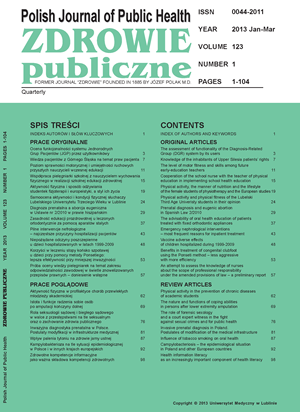Cooperation of the school nurse with the teacher of physical education in implementing school health education
DOI:
https://doi.org/10.12923/j.0044-2011/123-1/a.04Keywords:
school nurse, teacher of physical education, health education at schoolAbstract
Introduction. Since September 2012, pursuant to the decision of the Minister of National Education, a new curriculum basis has been in force in Polish schools, delegating almost all the tasks connected with implementing health education to the teacher of physical education and the subject taught by him/her. One of the closest partners of the teacher of physical education is supposed to be the school nurse.
Aim. The aim of the survey was to define the scope of cooperation of nurses working in educational communities and teachers of physical education in implementing health education nearly a year after introducing the new curriculum basis.
Material and methods. The opinions of 46 school nurses from two non-state healthcare centres were investigated. The analysed group consisted in 100% of nurses taking care over the total population of students of schools in Lublin (43,948 students in 87 different-type schools). A diagnostic survey and elements of monographs of selected schools were used, together with the analysis of documentation of the healthcare centres.
Results. Over 32% nurses stated that cooperation with teachers of physical education is very rare and less effective than with other teachers, and nearly 24% admitted that they did not cooperate with them at all. When cooperation occurs, in 58.7%, it concerns physical culture and promoting motor activity, prophylaxis of accidents and injuries (almost 48%), and education associated with hygiene (approx. 24%). Despite the fact that over 10% students are overweight or obese, only 5 nurses cooperate with the teacher of physical education in the field of nutritional education. Only 3 respondents identified the teacher of physical education as the leader of health promotion at school and confirmed his/her greater activity in the recent period. In Health Promoting Schools, nurses have a better opinion about teachers of physical education and they cooperate with them more often.
Conclusions. According to the surveyed school nurses, their cooperation with teachers of physical education in implementing school health education – excluding the area of motor activity – is minimal and ineffective, despite substantial needs in this domain existing in the population of students and new requirements put in front of teachers in the new curriculum basis.
References
1. Kann L, Telljohann SK, Wooley SF. Health Education: Results From the School Health Policies and Programs Study 2006. J Sch Health. 2007; 77(8):408-34. Review match
2. Charzyńska-Gula M. School health education as an element of the strategy of actions for public health. Lublin: Wydawnictwo, Drukarnia LIBER; 2001. p. 36-42.
3. Williams P, Weston R, McWhirter J, et al. Health promoting schools: lessons from working intersectorally with primary schools in Australia. Health Edu J. 1996;55(3):300-10. Review match
4. Bachman A, Kuei-Hsiang H. Evaluation of Online Education About Diabetes Management in the School Setting. Eur J Pub Health. 2006;17(1):21-6.
5. Smith C, Roberts C, Nutbeam D, Macdonald G. The health promoting school: progress and future challenges in Welsh secondary schools. Health Prom Int. 1992;7(3):171-9. Review match
6. Moon AM, Mullee MA, Rogers L, et al. Helping schools to become health-promoting environments – an evaluation of the Wessex Healthy Schools Award. Health Prom Int. 1999;14(2):111-22. Review match
7. Murray DM. Dissemination of community health promotion programs: The Fargo-Moorhead Heart Health Program. J Sch Health. 1986;9:357-81. Review match
8. Arbeit ML, Serpas DC, Johnson CC, et al. The implementation of a cardiovascular school health promotion program: utilization and impact of a school health advisory committee: the Heart Smart program. Health Edu Res. 1991;6(4):423-30. Review match
9. Woynarowska B. The history of health education in curriculum bases of general education 1997-2009. Zdrowie, Kultura Zdrowotna, Edukacja. 2009;3:29-40.
10. Better Schools through Health: The Third European Conference on Health Promoting Schools. Lithuania 15-17 June 2009. Vilnius: Published by LĮ Kriventa; 2009. p. 67-8.
11. Rozporządzenie Ministra Zdrowia z dnia 29 sierpnia 2009 r. w sprawie świadczeń gwarantowanych z zakresu podstawowej opieki zdrowotnej, Dz.U.09.139.1139 z dnia 31 sierpnia 2009 r.
12. Jodkowska M, Oblacińska A, Tabak I, et al. Nierówności w dostępie uczniów do profilaktycznej opieki zdrowotnej w Polsce w ostatnim roku wdrażania Rządowego Programu „Profilaktyczna opieka zdrowotna nad dziećmi i młodzieżą w środowisku nauczania i wychowania”. Instytut Matki i Dziecka, Zakład Ochrony i Promocji Zdrowia Dzieci i Młodzieży, Samodzielna Pracownia Medycyny Szkolnej. Warszawa; 2007. p. 19-21.
13. Walas L, Kachaniuk H, Pelc J. School community nurses’ satisfaction with the work they do. Zdr Publ. 2007;117(1):36-9.
14. Nagorski-Johnson A. School Health Partnering for Health Education: Pairing Clinical Students With School Nurses. J Special Pediatr Nurs. 2008;1(31):53-5. Review match
15. Phuphaibul R, Nantawan C, Tachudhong A, et al. Developing School Nurse Networking for Health Promotion Reorientation. In: RTG WHO Report – Health Promotion. Thailand: WHO Thailand Office; 2007. p. 26-9.


